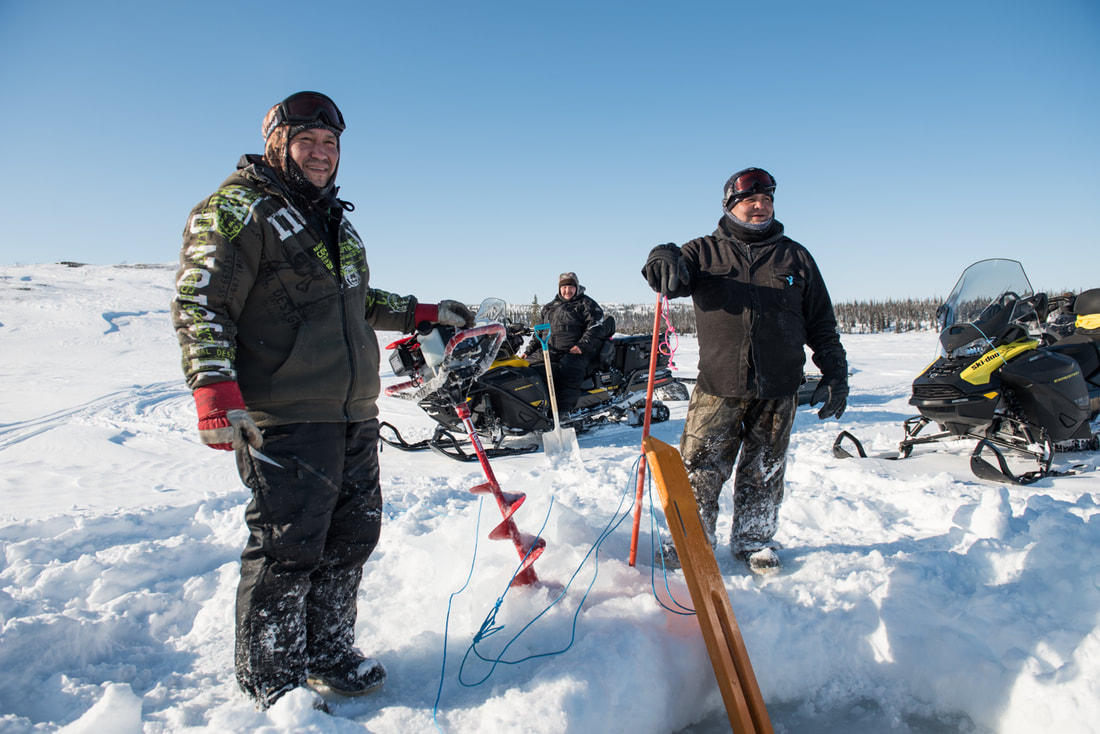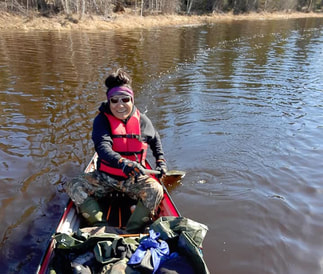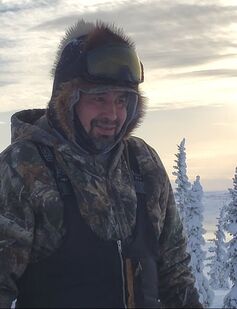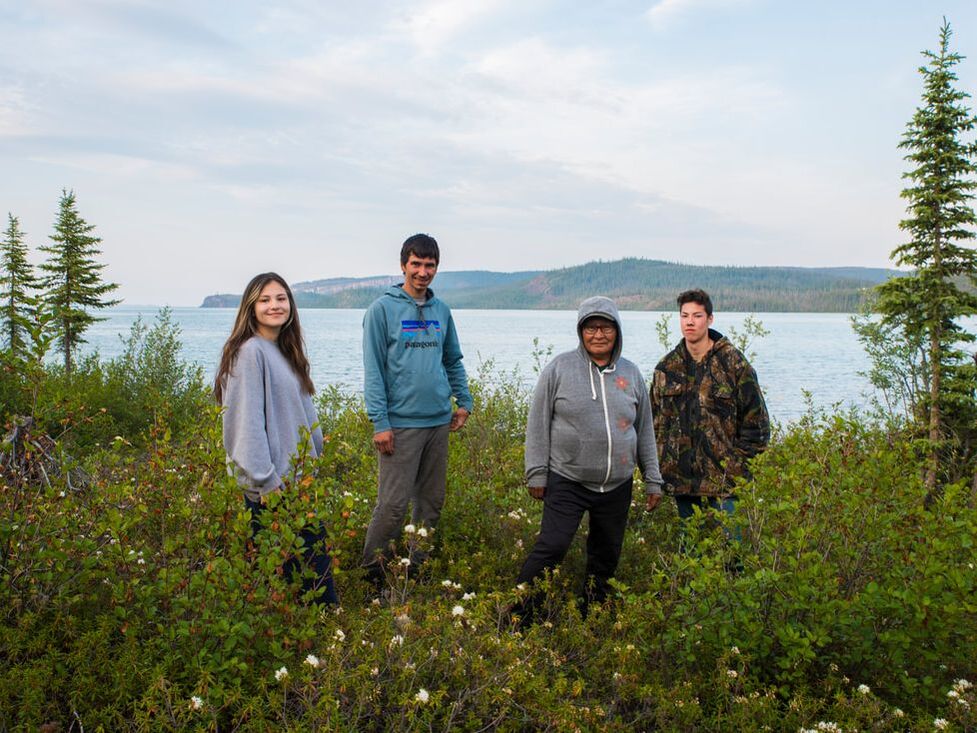 When the Thaidene Nëné Department announced it was in need of a new guardian last fall, Kevin Fatt jumped at the opportunity. “I’d been working in town way too much,” he explains. “I was always wanting to go out on the land, but there was never enough time.” A position with Ni Hat’ni Dene meant it would be Kevin’s job to spend time on the land. Kevin was no stranger to the department. He had been working on a contract basis since Ni Hat’ni Dene became a full-time, year-round program in January 2020. (Prior to this, Ni Hat’ni Dene guardians worked seasonally.) Kevin is well-suited to being a guardian. First, he has solid bush skills, having been raised by his maternal grandparents, Pierre and Mary Fatt. “They’re the ones that taught me how to live off the land,” Kevin says. “How to harvest, when to harvest, how to survive off the land.” Thanks to their careful instruction, Kevin came to love travelling on the land and spending time in the bush and on the tundra. Second, Kevin is a capable mechanic, who enjoys fixing things and problem solving. These are important skills for Ni Hat’ni Dene, who spend much of the summer and winter months away from the community out on patrol and need to be self-sufficient. Third, Kevin enjoys meeting new people, which is another feature of life on patrol. In the summer months especially, Ni Hat’ni Dene interact with visitors from all over the world, acting as ambassadors for the protected area. Like so many in the community, Kevin has to work to identify a favourite place in Thaidene Nëné. “It doesn’t matter where I am,” he says. “It’s just being out there.” If he has to choose though, he would pick Kaché (Fort Reliance) and Ts’ąkuı Theda (Lady of the Falls) because of the deep history that Łutsël K’é Dene have there and the many stories tied to the area. Kevin takes his position with Ni Hat’ni Dene seriously because it’s an inherited responsibility. “Our ancestors told us to watch over Thaidene Nëné,” he explains. “It’s our turn now to carry on their tradition.” Recognizing the importance of future generations to protecting the land and ensuring the continuation of Łutsël K’é Dene culture, Kevin wants to involve young people more in the work of caring for Thaidene Nëné, so one day they can take over this responsibility.  Bernice Marlowe joined the Thaidene Nëné team in early June. One of her first responsibilities as the new Ni Hat’ni Dene coordinator was to support the youth canoe trip to K’áı́hųká Tué (McLean Bay). The youth were also accompanied by traditional knowledge instructors, Sandra and James Lockhart. While on the trip, Bernice had a moment of déjà vu. “I realized James and Sandra had taught me stuff like this when I was in school, and they’re still teaching me,” she exclaims. “Who would have thought that I would have been doing this?” Young Bernice may not have anticipated becoming the Ni Hat’ni Dene coordinator—she had her heart set on being a geologist—but she would have welcomed the opportunity to spend time in the bush as part of her job. Born and raised in Łutsël K’é, when Bernice and her siblings weren’t in school, they were out on the land. she recalls, “My late dad, George Marlowe, was a big role model for me, being out on the land. He always took me out. He taught me the way of life, and bush skills.” Both of their parents, George and Celine, had day jobs in the community, so the Marlowe girls and their brother, Darren, also spent time in the bush, learning from their maternal grandparents, Marie and Bruno Nataway, and their uncles. When Bernice had kids—she and her partner, Paul Catholique, have three sons: Troy, Tyson, and Nuni—they were trained in the same way. Bernice says, “My late Dad took my boys out on the land as much as possible, right up until he couldn’t be mobile anymore. He showed them what he taught me.” A plane crash at Utsingi Point in 2011 left Bernice unable to work. “For a long time,” she explains, “I was in this mode from my plane crash. I was staying in my room all the time.” In addition to support from her mom, Paul, sister Amanda, and other family, spending time on the land was an important part of Bernice’s healing journey. She says, “Every time I went out on the land, I felt more like I could breathe. I felt safe.” Bernice was living next to the Thaidene Nëné offices while she was recovering. “I realized that I wanted to work for the department. I said to my mom: How do I get a job there? And she said, ‘Picture in your head what you want to do. Picture it in your head and repeat it everyday.’” Celine’s advice must have worked, because Bernice is now responsible for coordinating the activities for the Ni Hat’ni Dene program and managing the guardians. “What I like about my job,” she explains, “is being able to take care of the guys because they are our guardians. I like to make sure they are well-equipped for every season. I also like being able to work with the young people, show them the way of life, and share bush skills and knowledge.” For Bernice, Thaidene Nëné means “land watchers, guardians. The people who take care of our land, who protect our land.” She thinks of her children and the other young people in the community when asked why it is important to protect the land: “It’s because of our kids, our kids’ kids, the next generation and the generation after that.” Bernice wants to ensure that future generations are able to live and travel on the land the way her grandparents did, the way that she has been able to do. “Travelling and harvesting,” she says, “that is our lifestyle. I don’t know what would happen if we weren’t able to do that.” As much as Bernice is thinking about future generations, she also feels a responsibility to those of long ago: “This land is where my ancestors were at one time. It was passed down to me that it is my duty to protect it.” Bernice feels a special connection to Ts’ąkuı Theda (Parry Falls), a place that grounds her, and also to Ɂedacho Tłaze (Timber Bay). “Every time I go up there, she says, “I get so emotional. I cry with happiness when I arrive, and then I cry when it’s time to go because I have to leave. Part of me is up there. I feel at home when I’m there. It’s been that way ever since I was a little girl.” But there are lots of places in the Thaidene Nëné Indigenous Protected Area that are new to Bernice, and she looks forward to visiting them in her role as the Ni Hat’ni Dene coordinator. This is part of a series of profiles about the staff, leaders, and community members who are hard at work implementing Łutsël K’é Dene First Nation's vision for the Thaidene Nëné Indigenous Protected Area. You can read the other profiles here.  Paul Catholique is the newest Ni Hat’ni Dene guardian. Paul brings a wealth of experience living and working on the land to the crew. For a decade, he spent his summer months working as a guide at Frontier Fishing Lodge, showing guests the best fishing spots on Tu Nedhé (Great Slave Lake) and sharing the history and the culture of the area with them. He also spent ten years working for forestry, first as a fire crew member and later as a crew boss and supervisor. In between contracts, Paul would hunt and trap, using the skills he learned from his father, John Catholique (his mother is Bertha Collins [Tłı̨chǫ]). “From a young age, we went trapping,” he says, often working out of a cabin on Ts’ǫ Ɂáı Tué (Noman Lake). His uncle, Antoine Michel, also played a critical role in teaching Paul how to live off the land, especially beyond the treeline. “He used to take us out to the barrenlands every year,” Paul recalls. “As soon as it was frozen, we would go to the barrenlands by skidoo. We went often, sometimes three to fifteen times a year.” Paul credits his uncle Antoine with teaching him to navigate in the springtime, when it’s more dangerous to travel on the land—“You have been really knowledgeable at that time of year,” he says—and also with showing him the old routes and roads. Equally important to his education as a harvester and land user was knowledge shared by Łutsël K’é Dene elders: “When I was in town, I would listen to the elders talk and tell stories.” His greatest teacher, though, was the land itself. In Paul’s words, “I learned from going all over on the land, trapping, travelling, and just living on the land.” When asked about his favourite places in Thaidene Nëné, almost all of Paul’s picks are beyond the treeline: Ɂedacho Tué (Artillery Lake), Dené Bésda Tué Chogh (Fletcher Lake), Ɂejëre K’áanı́ Tué (Campbell Lake), and K’ásba Dezé (Ptarmigan River). Contrary to the image suggested by the name barrenlands, Paul see the tundra as a place of abundance, “Everything I need is there.” Hazú (tundra) is also special because of the connection to his ancestors. Paul’s great-grandfather Gahdële is buried on Ɂedacho Tué. Paul wanted to be a Ni Hat’ni Dene guardian because the job description is basically his life. “This position was made for me,” he says. More than this, Paul, like many in the community, wants to protect the land and Ni Hat’ni Dene play a critical role in that. “We need to protect the land, the water, the animals, the trees,” Paul explains. “We need to protect the old campsites, the old burial sites.” Working alongside the other guardians, Paul will be responsible for mentoring the summer students. By creating hands-on learning opportunities, he notes, Ni Hat’ni Dene “can help make it safer to send younger people out on their land.” Being a skilled and conscientious land user is important to Paul; so is modelling Łutsël K’é Dene values. As just one example, he notes that “Ni Hat’ni are teaching young people how to put nets in the water, so they can share the fish with the community, with the elders.” Paul also sees the important role that Ni Hat’ni Dene play in welcoming visitors to Thaidene Nëné, while also teaching them how to live and travel safely on the land. “The things we teach the young people are good for visitors too,” he says. “We don’t want them to be left out. Everybody is welcome.” This is part of a series of profiles about the staff, leaders, and community members who are hard at work implementing Łutsël K’é Dene First Nation's vision for the Thaidene Nëné Indigenous Protected Area. You can read the other profiles here.  Terri Enzoe was born on hazú (the barrenlands). Her parents, Elizabeth (Nitah) Enzoe and Billy Enzoe, named their daughter Doris (pronounced Door-ass), the Dënesųłıné version of Terese. Later, travelling by canoe, the family moved to Reliance, where there was a trading post, then eventually to Snowdrift as Łutsël K’é was then known. In the fall time, the family would relocate to the bush to trap and harvest, returning to the community at Christmas. The rest of the year, Billy Enzoe did odd jobs. Terri was raised with a foot in two worlds, though her heart is on the tundra. Today, Terri, who lives in Łutsël K’é with her partner Andy, takes every opportunity to be out on the land, most often travelling with her son, Kyle, who she describes as “made for the bush.” (Terri is mother to three other children and grandmother to six.) When she’s in town, Terri can be found fixing meat, tanning hides, and sewing—her expertly crafted designs are available through Caribou People Creations. Terri was a familiar face at the community meetings that were critical to the establishment of Thaidene Nëné. When she thinks about Thaidene Nëné, Terri recalls those meetings and the elders’ commitment to protecting the land for younger generations. “The elders knew that development was coming and that it might destroy our water and our animals,” Terri says. The elders called the area of land they wanted to protect, Thaidene Nëné. “Thaidene means long time ago, the old timers,” Terri explains. “Thaidene Nëné is where our ancestors used to live long time ago.” It was Terri’s sister, Gloria Enzoe (now Shearing), who started Ni Hat’ni Dene, which means “watchers of the land” in Dënesųłıné, in 2008. Terri and her son, Kyle, applied because they were looking for a man and a woman to serve as guardians. Terri saw the utility in that approach: “That way you can bring young girls and young men out, to teach them both how to live off the land.” Over ten summers, Terri worked closely with young women and men from the community, sharing her knowledge of how to live on the land, but also Dënesųłıné language and culture. She recalls, “We showed them spiritual places, burial sites, the places where our ancestors used to live. We showed them where you have to be quiet, where you have to pay the water. We showed them that this is a good place for stopping when it’s windy. This is a good place for fishing. And we’d tell them how it used to be long time ago.” Terri has many stories from the decade that she spent travelling the land and water with Ni Hat’ni Dene. There was the time, for instance, they were winded for five days at the Ni Hat’ni cabin at Talthelie Narrows. Terri, Kyle, and the four summer interns busied themselves setting and pulling a net for fish sampling. Together the group processed 17 trout and 67 jumbo whitefish. Just as they finished, they turned around and there was a moose. After fixing the meat, the group travelled back to town. “I went to the store and told everyone, ‘There’s lots of fish, lots of moose.’ I spent the rest of the day giving away fish and meat,” Terri remembers with a big grin. Today, Terri is a member of the Łutsël K’é Dene First Nation council and Sub-Chief of the community. In that capacity, she is supporting and helping to guide Łutsël K’é’s work in Thaidene Nëné. Terri believes strongly that the success of Thaidene Nëné is directly related to youth: “We have to motivate our young people. We have to tell them how we used to live and how we’re going to live today. The life cycle has all changed now—it’s so different—but we still have to keep our old ways of living if we want to keep Thaidene Nëné.” This sharing of knowledge is critical to the future of the Indigenous protected area. Terri likens the way forward to a path: “If you follow those footprints, it will go on to the next generation and the ones after that. If you don’t, it stops there. The path ends. Then there’s no Thaidene Nëné.” This is part of a series of profiles about the staff, leaders, and community members who are hard at work implementing Łutsël K’é Dene First Nation's vision for the Thaidene Nëné Indigenous Protected Area. You can read the other profiles here. When Darryl Marlowe was first elected chief of the Łutsël K’é Dene First Nation in March 2017, he was 30 years old, making him the youngest person in the community’s history to hold that office. Darryl was happy to have been re-elected for a second term in October 2020: “I really enjoy working for my people, protecting our land, protecting our treaty rights, protecting our inherent rights.”
When he’s not advocating for his people and Thaidene Nëné, Darryl loves spending time on the land with his family, including his five children. Darryl was taught to travel and live on the land by his grandparents, George and Celine Marlowe and Henry King and Maryrose Boucher, and his parents, Kenneth and Elizabeth Boucher. He also found a skilled and willing mentor in his father-in-law, Archie Catholique, who’s been taking Darryl out hunting by boat and skidoo since he was 16. It is not just the skills needed to be a hunter that were passed on to Darryl, but also Dënesųłıné ethics: “When we go out, we go out as a group. We hunt together and stay together. We help each other, we take care of each other. We also respect the land and the animal. Every time we harvest an animal, we are grateful. We put down tobacco. We say thank you to the animal’s spirit. That animal giving its life allows us to provide for our families.” While Darryl loves to visit Ts’ąkuı Theda (Lady of the Falls) and Kaché (Fort Reliance), all of Thaidene Nëné is special for the chief, which is why he feels so strongly about the community’s decision to designate it an Indigenous protected area: “We are protecting the heart of our traditional territory from development for the long term. We want to ensure that our way of life, our culture, our land, our water, our animals will be protected for many years to come.” In protecting Thaidene Nëné, the community of Łutsël K’é is seeking to realize the vision of their ancestors through guidance provided by the elders. Darryl explains, “Everything that we have done is for the future. That’s what our elders used to say: yunedhé xa, which means for the future. All of this work is for future generations. We are leaving them a legacy.” Darryl wasn’t even born when the discussions of a park first surfaced, but he is honoured to have been able to be part of the process in recent years. In particular, he is proud of the way the community has worked with other partners to have portions of the Thaidene Nëné Indigenous Protected Area designated as a national park reserve, a territorial protected area, and a wildlife conservation area: “I’m glad we took the initiative to develop relationships with two crown governments. At a time when people are talking about reconciliation, we are an example for the rest of the country.” In addition to providing the heart of the community’s traditional territory with long-term protection from development, Darryl envisions other benefits for the community as they work to develop a tourism and conservation economy through Thaidene Nëné, including employment that is sustainable and meaningful for Łutsël K’é Dene. Darryl is particularly enthusiastic about the possibilities afforded by Ni Hat’ni Dene. As Darryl notes, “It’s a dream job for people because they get to spend time out on the land.” As importantly, the community relies on the guardians “to ensure that people are being respectful of Łutsël K’é’s traditional territory.” At present, all of the guardians are men. Going forward, Darryl would like to see women on the crew: “They can inspire and open up opportunities for younger generations.” With a national park reserve and territorial protected area within its borders, Thaidene Nëné will welcome visitors from across the territory, the country, and around the world. Darryl would like to remind visitors that Thaidene Nëné is sacred for the Łutsël K’é Dene, but also that the community depends on the land to sustain itself and its way of life: “Our elders modelled respect for the land. It is our responsibility as young leaders to do the same and to pass this teaching on to others.” |
AuthorWrite something about yourself. No need to be fancy, just an overview. Archives
July 2024
Categories |
CONNECT |
VISIONWe are the Lutsel K’e Dene First Nation. Our vision for Thaidene Nëné is:
Nuwe néné, nuwe ch'anıé yunedhé xa (Our land, our culture for the future). We’re working with our partners to permanently protect Thaidene Nëné—part of our huge and bountiful homeland around and beyond the East Arm of Tu Nedhé. |
